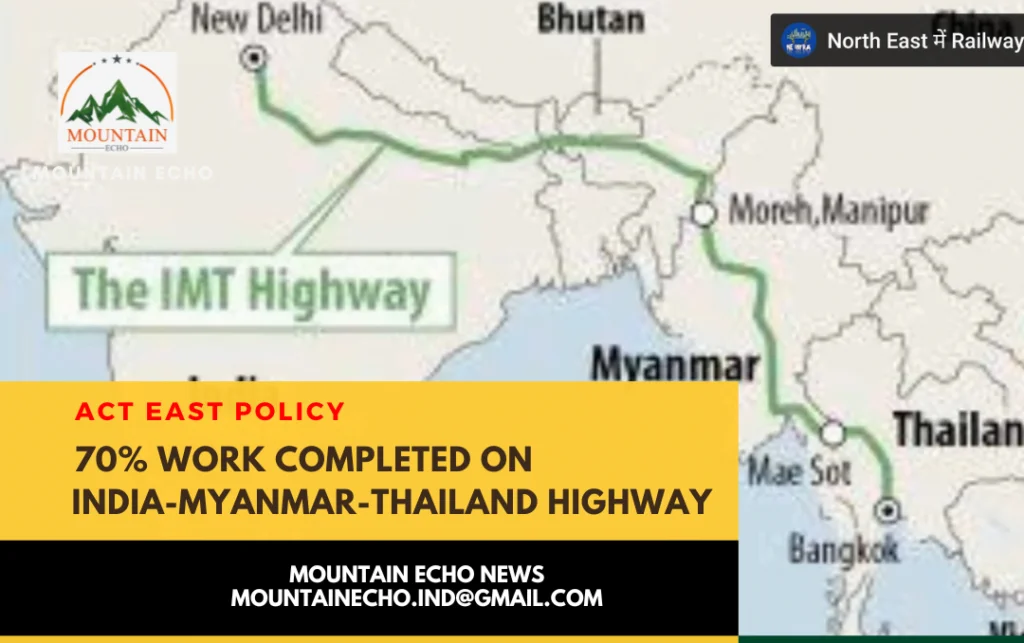India Myanmar Thailand Trilateral Highway nearing completion
WhatsApp Channel
Join Now
The India Myanmar Thailand (IMT) International Highway stands as a remarkable example of transnational infrastructure, interlinking India’s northeastern state of Manipur with Thailand’s Mae Sot via Myanmar. This ambitious project not only underscores India’s Act East policy but also symbolizes the convergence of diplomatic relations, economic aspirations, and geopolitical strategies among these nations. Stretching across approximately 1,400 kilometers, this road network was initially conceptualized by former Indian Prime Minister Atal Bihari Vajpayee and received unanimous approval from India, Myanmar, and Thailand in 2002. The commencement of construction occurred in 2012, signifying a substantial leap towards regional integration.

The strategic significance of the IMT trilateral highway extends beyond its physical infrastructure. It holds the potential to foster a multidimensional transformation – economically, diplomatically, and in terms of security. Notably, Myanmar’s unique position as an ASEAN nation sharing a land border with India amplifies its role as a crucial conduit bridging the Indian subcontinent and Southeast Asia. By bolstering connectivity with Myanmar, the path to heightened economic integration becomes discernible. Furthermore, this route offers a tactical means for India to counterbalance China’s burgeoning influence in Myanmar while concurrently addressing security concerns linked to insurgent activities in Northeast India.
In the spectrum of geopolitical maneuvering, the highway is instrumental in expanding the horizons for India’s northeastern states. By dissolving their economic seclusion, the road opens up a vast market within the ambit of Southeast Asian nations. The anticipated economic growth in the region acts as a catalyst for overall development, mitigating the lingering isolation that these states have historically faced. This interconnectedness not only aligns with India’s broader economic goals but also paves a path for harmonious people-to-people interactions across borders.

The India Myanmar Thailand (IMT) highway galvanizes the efficacy of the free trade agreement between India and ASEAN countries, laying the groundwork for a symbiotic partnership. The seamless flow of goods and services facilitated by this infrastructure can be transformative, invigorating business transactions and attracting investments to the Northeastern region. Harnessing the latent potential of these states aligns seamlessly with India’s aspirations of propelling its economy to the coveted $5 trillion mark by 2025.
However, the journey towards realizing this ambitious venture is not without challenges. The political turbulence that has occasionally gripped Myanmar has led to delays in construction, underscoring the inherent vulnerability of transnational projects influenced by regional dynamics. The ongoing situations in Manipur may also have a huge impact and cause delays in completing the project on time on the Indian stretch of the IMT Highway.
Vijavat Isarabhakdi, Vice Minister for Foreign Affairs of Thailand said that 99 per cent of the Thailand section is completed. The rest will depend on how fast Myanmar and India can complete their section of the project, as quoted in an HT Auto report.
MORTH Minister, Nitin Gadkari told PTI that around 70 per cent of work on the trilateral highway is completed. The highway will connect the ASEAN countries by land and help in encouraging trade, business, tourism, education and health ties among the countries.
The rugged terrain, especially at the India-Myanmar border, coupled with high rainfall poses formidable obstacles in the path of construction. Negotiating steep gradients and intricate curves presents a formidable challenge for the dedicated workforce involved.
The IMT International Highway emerges as an emblem of the intricate interplay between diplomacy, economics, and security in the modern era. Beyond being a mere road, it is a conduit that exemplifies the convergence of aspirations, the transformation of geographies, and the realization of regional cooperation. As it inches towards completion, this highway brings with it the promise of economic prosperity, diplomatic synergies, and a strengthened geopolitical footing for India, Myanmar, and Thailand alike.
Telegram Channel
Join Now



